How Building Made Us Better Architects
Oct 29, 2020
Every architect has their calling card. Michael and I often throw ours down to demonstrate the dynamic our clients can expect to see: detail balanced with creative vision. We embody an almost stereotypical dichotomy of the two types of architects, myself as the technical architect making schedules and running teams, Michael as the typical creative ignoring my schedules and constantly moving projects in unexpected directions with creative solutions.
For all the variances in our methods, Michael and I lead Level with a shared appreciation for the thing that I believe defines our company: we build things ourselves, with our own hands. We are weekend warriors: me in my garage woodshop, with neverending home improvement projects; Michael on his land, making things from scratch—a skid steer and a chainsaw mill.
This infatuation with construction has defined our careers. It drove Michael’s ambitious undertaking of building his parent’s rural cabin the summer after grad school, and led me to the Cincinnati Bengals Stadium construction site as a young intern. Throughout the years, we have continued to put ourselves in the position of laborer, carpenter, tile guy, electrician, GC, and construction manager throughout our “architectural” careers. After meeting and recognizing a familiar drive to build things in the other, we even briefly led a design build construction company. Through these endeavors, Michael and I both got the opportunity to build our own mistakes—a long, humbling process that ultimately made us the kind of architects we are today.
The calluses incurred inform how we work, both in our approach and in our collaborations. When we begin designing a project, our understanding of the physical, minute elements comes into play early. Our designs are so buildable because we understand in a very real way what it's going to take to make them come to life.
Second, we have a much deeper appreciation for the team. Oftentimes, there can be tension between contractors and architects, each carrying reservations about the other. In our teams, the ego is dropped. Our process is about listening, asking the right questions, and knowing how to navigate the entire team to a collective answer. Since we have had experience in the trade, we understand what the general contractor or fire protection consultants bring to the table, and what aspects are going to be important to their own process. This understanding makes it easier to produce a much more cohesive project—a clarity that sets us apart from other teams in the industry.
Here are a few projects we built with our own hands, or as construction managers along the way…
Feature Wall
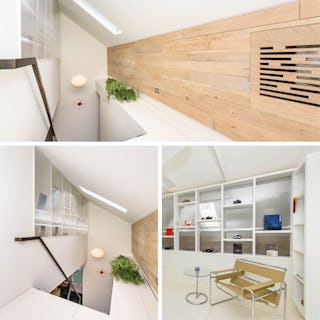
I had originally conceived this as fully open from the guest room to the stair, but was quickly informed by my wife that some privacy might be appreciated by the guests. The wall is framed with conventional painted 2x8’s, and the 2x8’s on the stair side are clad with polycarbonate. The grooved wood below the shelving and the pickled wormy chestnut to the right of the stair were both salvaged from a mid-century modern rehab project in Wilmette. I worked as the designer and the carpenter on this project. - Greg
Nica Side Table
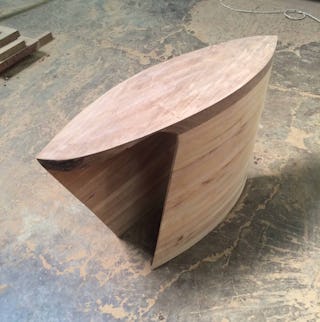
In 2017, my son and I took a trip to Nicaragua, in part to visit my wife's cousin Aram Terry who started and runs a furniture company called Masaya & Co. While my son started several laminated sculptural pieces, I discovered a dumpster with remnants of a rocking chair base (many, many half-moon shaped discards from the rocking shape). The quantity was impressive, and there seemed to be an opportunity, so I collected the pieces, a half gallon of glue, and some bar clamps. Not knowing what the result might yield, I started playing around with stacks of these crescent shaped pieces, and came up with two slightly shifted stacks, like a yin/yang three dimensional construct. After putting them together and placing them in opposition to one another, I realized that by putting a football-shaped top on the two bases a functional side table could be created. The shape was interesting and elegant, and after some sanding/planing to unify the shape of the overall piece, the final product was achieved. Aram was kind enough to mail the piece to my home, and asked for permission to reproduce the piece as part of the collection. You can find it on their site, now named “Velero Side Table.” - Michael
Customized Shower Bench
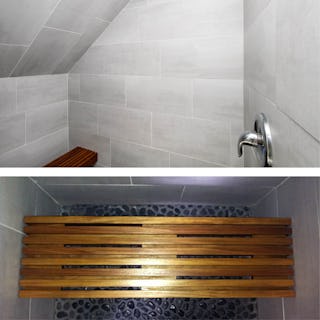
I designed this shower, as well as installed the tile and worked as the carpenter on the bench. The bench is comprised of through-bolted Afromansia slats. The bench is removable for cleaning and rests on wall clips that mortised into the bottom of bench. - Greg
Sawmill
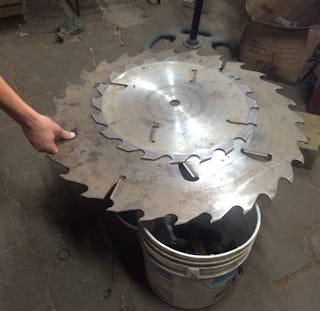
Though the blades shown in the photograph would excite any would-be sawyer, the scope of our milling operation is still a work in progress. Our initial experiments consist of the purchase of an Alaskan Chain Saw Mill, which is a contraption that bolts onto a chain saw and, when run through a guide attached to a length of a log, will make a straight cut over the length of the log. After the first cut, the mill can be set to a depth (in our case 2”) and the next board cut will be 2” thick, with what is known in the business as “live edges” where the precise cut gives way to the outer bark and round profile of the tree. We were left with two 2” thick slabs, approximately 16” wide, and 8’ long which will eventually turn into a bench, table top, or something similar in the future. It takes about 10 minutes to run the chainsaw the length of an 8’ long oak log, and also dulls the blade of the saw, so this won't be the way to mill a large quantity of trees. However, good starting exercise. - Michael
Residential Low Deck
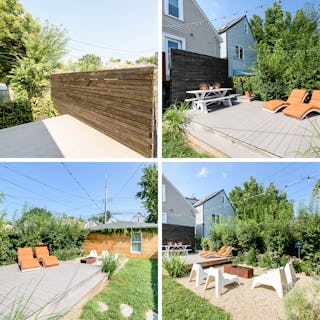
I worked as the designer and carpenter on this residential deck project. I like to think of low decks as hovering above the ground. The structural system has cantilevers inherent to it that support this effect. I used Timbertech decking with hidden fasteners on pressure treated framing. The screen walls is made from the previous deck that occupied this space which was removed, milled, stained and sealed. The cantilever rail is bent corten steel. - Greg
Range Line Road
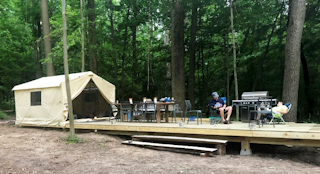
A few years back, my family purchased a lot in Michigan along with another family. We had the idea to build a shared compound that could be used by both families as a city getaway. During quarantine, we've made some progress on the site, clearing out trees and building vegetable patches. I've worked on getting a deck set up that offers a slightly more domesticated set-up than the back-country living we were doing before. To follow along with this in-progress project, check out the installments of Range Line Road. - Michael